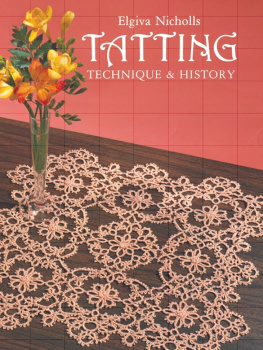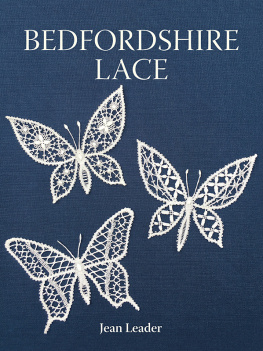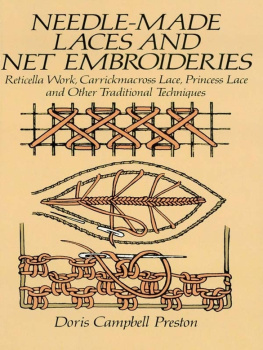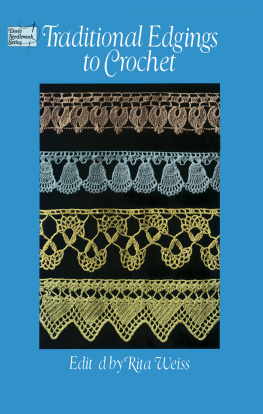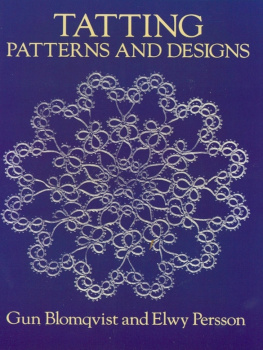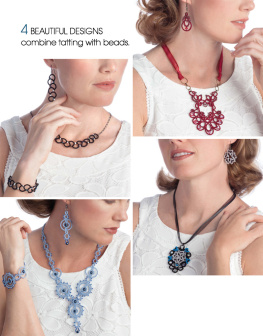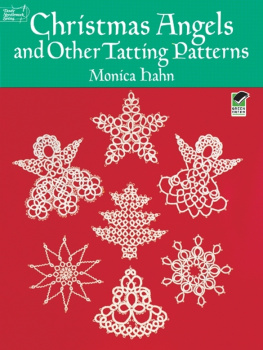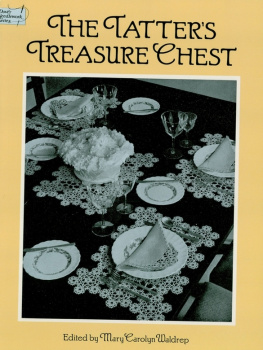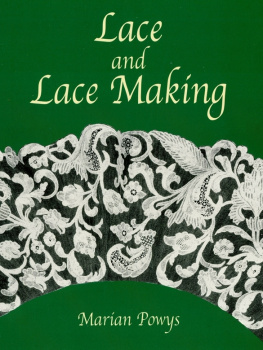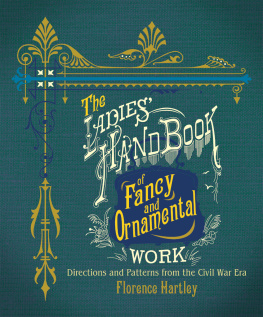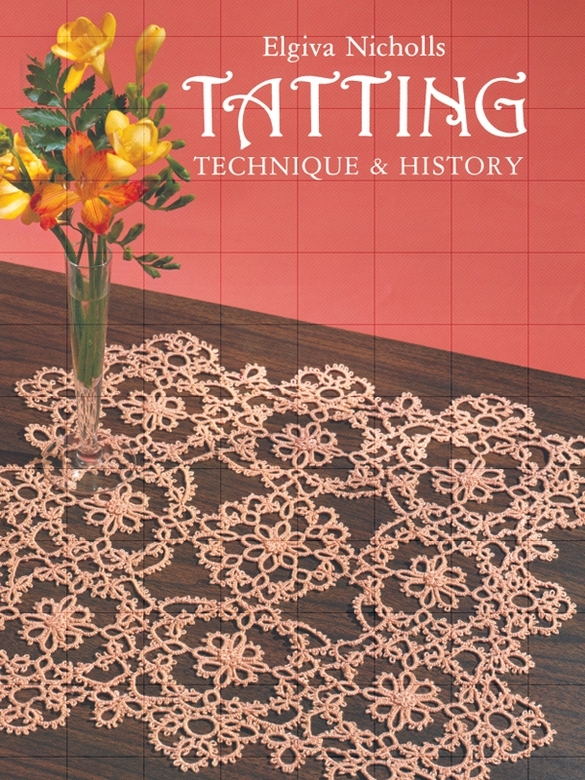Acknowledgements
Acknowledgements are made to those who have kindly lent old tatting books, from which the development of the craft has been compiled, and particularly to N. M. Lewis, an authority on old patterns, whose specialized knowledge and manual skill have also contributed to the text and illustrations.
The author is indebted to the DMC Library for information concerning the life and work of Thrse de Dillmont.
Bibliography
KNOTS, USEFUL AND ORNAMENTAL. George Russell Shaw, Cambridge (Mass.), U.S.A.
LEARN To TAT. J. & P. Coats Ltd., Paisley.
TATTING, Book I. Penelope, Manchester.
LA FRIVOLIT. Thrse de Dillmont, Bibliothque D.M.C., France.
ENCYCLOPAEDIA OF NEEDLEWORK. Thrse de Dillmont, Alsace.
TATTING ILLUSTRATED. Norma Benporath, Melbourne, Australia.
SCHIFFCHENARBEIT. Wiesbaden, Germany.
IL LAVORO CHIACCHIERINO. Milan, Italy.
FRIVOLITETSMNSTER. Sara Lawergren, Malm, Sweden.
PRIMORES FEMENINOS. Barcelona, Spain.
THE ART OF TATTING. Lady Hoare, London.
THE ILLUSTRATED EXHIBITOR AND MAGAZINE OF ART. London.
A NEW LOOK IN TATTING. E. A. Nicholls, London.
Books by Mlle Eleonore Riego de la Branchardiere:
The Tatting Book, 1850, and subsequent editions.
Tatting Edgings and Insertions, 1861.
Golden Stars in Tatting and Crochet, 1861.
The Exhibition Tatting Book, 1862.
The Complete Tatting Book, 1863 and 1866.
The Royal Tatting Book, 1864.
The Lace Tatting Book, 1866.
Simple Book of Tatting, 1867.
The Pearl Tatting Book, 1867.
The Raised Tatting Book, 1868.
TATTING MADE EASY, 1851. A lady, London.
THE LADIES HANDBOOK OF MILLINERY, DRESSMAKING AND TATTING, 1843.
THE LADIES WORKTABLE BOOK, 1850.
BEETONS BOOK OF NEEDLEWORK, 1870.
DICTIONARY OF NEEDLEWORK. Caulfeild and Saward.
Periodicals, from 1860:
The Englishwomans Domestic Magazine: an illustrated journal, combining practical information, instruction and amusement.
The Young Englishwoman: a volume of pure literature, new fashions and pretty needlework designs.
CHAPTER I
Definition of the Craft of Tatting
A KIND of knotted work, used for trimming and A kind of lace are dictionary definitions. What then is lace and the properties which distinguish it from other fabrics produced from a spun thread?
The chief characteristic of lace in all the stages of its development is its contrast to the uniform surface of woven fabrics. Lace is a combination of open spaces and compact texture, of transparent and opaque patterns, of light and heavy parts. In its most delicate form it has become a light, flimsy texture, the most subtle expression of textile art.... Its first appearance was in the sixteenth century.
So writes an authority on lace structure; and tatting does in effect conform to this definition, in its essentials. It could in fact be termed poor mans lace, for at one time it was used as a representation of the fine laces worn at Court by aspirants to fashion. In 1851 at the Great International Exhibition, a certain Mlle Riego de la Branchardire received four awards including the Prize Medal for the skill displayed in the imitation of old Spanish and other costly laces.
While real lace required a pillow, pins, a number of bobbins, needle and thread, a net foundation, etc., according to its kind, all that was needed for tatting was the hand, for the stitch is formed over the fingers: the shuttle merely carries the thread in a convenient manner, more convenient than a ball of some size. The stitch could also be formed by a needle on a long stretch of thread, or indeed without the aid of either. Tatting is in fact so simple that it is frequently confused by the uninitiated with crochet, which often appears to resemble it. The only feature it has in common with crochet (and knitting) is the fact that it is worked from one thread direct from the ball (or shuttle). Fabrics so made are distinct from those woven on a loom, in which one thread weaves in and out of warp threads previously set up on a frame.
In knitting, the stitches are supported on needles; in crochet the new stitch is hooked into the previous one; but in tatting each stitch is an independent progression, out of the air, relying neither on mechanical support nor upon previous stitches. Crochet is formed of intersecting loops, which stretch according to the nature of the thread used: the shape of the article is inclined to collapse when it is suspended. Tatting is a row of knots carried on a core of an internal thread: it is therefore firmer and stronger.
One of the features of lace is that it can show something of contemporary life and custom pictorially, by depicting through its design royal, heraldic or historical motifs, figures, etc. incorporated in its structure. In a more limited manner, the same can be said of tatting. In the free-style technique, stylised representations of flowers portraying the national emblems have been made, and older pieces for ecclesiastical use show biblical subjects. Carved stone tracery and lace are very closely allied; tatting also, as it is able to indicate architectural styles gothic, rococo, flamboyant in some degree. But apart from design, the uses to which tatting is put are a strong indication of the customs of the time. Lace was too delicate, too slow to make, to be used for common articles. Tatting could be in everybodys hands, as it could be made of very thick thread if required. It follows the fashion in dress and furnishings, and what are now called accessories. Trimmings on drawing-room aprons, cravats, antimacassars, covering for a parasol, were common in Victorian times: earlier there were lanyards to carry fans attached to the Regency waist belt. These were made of thick silk cord and required very large shuttles. Head-shawls, jabots and fichus were produced in the Netherlands: the most delicate and imaginative insertions and edgings came from the shuttles of France, where underclothes were so lavishly trimmed in the nineties, using the finest thread. Adornment for church vestments and altar cloths, in gold thread carrying precious stones, came from eastern Europe at a later period. Many of these articles, now no longer in common use, tell something of the history of the time. So do our contemporary patterns, reflecting the taste, skill, and requirements of today.
As a craft, tatting both gains and loses in working conditions over the years, rising and waning in popularity. The very fine earlier pieces must have been constructed by the light of a candle (perhaps refracted through a glass bowl of water, an old lace-makers method of focusing the rays of light on to a single point). Now at least there is adequate artificial light. On the other hand there are a greater number of distractions, in the form of alternative and attractive types of hand-work, and the competition of television, with which it now has to contend.
Like many crafts, after a dormant period, tatting depended on someone sufficiently gifted to bring it again to popular notice, and to carry its evolution a step farther. During the last hundred years, four names are outstanding. But before this, and during the eighteenth century, very little seems to have been written, or at least preserved, on the subject at that time. It must have been a peak period, since constant reference is made to it in later works, by almost all the nineteenth-century writers, and the distinctive shuttles of that period remain as evidence. It was certainly a royal accomplishment in both England and France early in the eighteenth century and before. In England, William of Orange and Mary were on the throne from 1689 to 1702. In 1707 Sir Charles Sedley published a short poem called The Royal Knotter referring to what is described by Lady Hoare as the Queens homely habits.

